Jing Yao
IROTE: Human-like Traits Elicitation of Large Language Model via In-Context Self-Reflective Optimization
Aug 12, 2025



Abstract:Trained on various human-authored corpora, Large Language Models (LLMs) have demonstrated a certain capability of reflecting specific human-like traits (e.g., personality or values) by prompting, benefiting applications like personalized LLMs and social simulations. However, existing methods suffer from the superficial elicitation problem: LLMs can only be steered to mimic shallow and unstable stylistic patterns, failing to embody the desired traits precisely and consistently across diverse tasks like humans. To address this challenge, we propose IROTE, a novel in-context method for stable and transferable trait elicitation. Drawing on psychological theories suggesting that traits are formed through identity-related reflection, our method automatically generates and optimizes a textual self-reflection within prompts, which comprises self-perceived experience, to stimulate LLMs' trait-driven behavior. The optimization is performed by iteratively maximizing an information-theoretic objective that enhances the connections between LLMs' behavior and the target trait, while reducing noisy redundancy in reflection without any fine-tuning, leading to evocative and compact trait reflection. Extensive experiments across three human trait systems manifest that one single IROTE-generated self-reflection can induce LLMs' stable impersonation of the target trait across diverse downstream tasks beyond simple questionnaire answering, consistently outperforming existing strong baselines.
Unintended Harms of Value-Aligned LLMs: Psychological and Empirical Insights
Jun 06, 2025Abstract:The application scope of Large Language Models (LLMs) continues to expand, leading to increasing interest in personalized LLMs that align with human values. However, aligning these models with individual values raises significant safety concerns, as certain values may correlate with harmful information. In this paper, we identify specific safety risks associated with value-aligned LLMs and investigate the psychological principles behind these challenges. Our findings reveal two key insights. (1) Value-aligned LLMs are more prone to harmful behavior compared to non-fine-tuned models and exhibit slightly higher risks in traditional safety evaluations than other fine-tuned models. (2) These safety issues arise because value-aligned LLMs genuinely generate text according to the aligned values, which can amplify harmful outcomes. Using a dataset with detailed safety categories, we find significant correlations between value alignment and safety risks, supported by psychological hypotheses. This study offers insights into the "black box" of value alignment and proposes in-context alignment methods to enhance the safety of value-aligned LLMs.
SegEarth-R1: Geospatial Pixel Reasoning via Large Language Model
Apr 13, 2025Abstract:Remote sensing has become critical for understanding environmental dynamics, urban planning, and disaster management. However, traditional remote sensing workflows often rely on explicit segmentation or detection methods, which struggle to handle complex, implicit queries that require reasoning over spatial context, domain knowledge, and implicit user intent. Motivated by this, we introduce a new task, \ie, geospatial pixel reasoning, which allows implicit querying and reasoning and generates the mask of the target region. To advance this task, we construct and release the first large-scale benchmark dataset called EarthReason, which comprises 5,434 manually annotated image masks with over 30,000 implicit question-answer pairs. Moreover, we propose SegEarth-R1, a simple yet effective language-guided segmentation baseline that integrates a hierarchical visual encoder, a large language model (LLM) for instruction parsing, and a tailored mask generator for spatial correlation. The design of SegEarth-R1 incorporates domain-specific adaptations, including aggressive visual token compression to handle ultra-high-resolution remote sensing images, a description projection module to fuse language and multi-scale features, and a streamlined mask prediction pipeline that directly queries description embeddings. Extensive experiments demonstrate that SegEarth-R1 achieves state-of-the-art performance on both reasoning and referring segmentation tasks, significantly outperforming traditional and LLM-based segmentation methods. Our data and code will be released at https://github.com/earth-insights/SegEarth-R1.
CAReDiO: Cultural Alignment of LLM via Representativeness and Distinctiveness Guided Data Optimization
Apr 09, 2025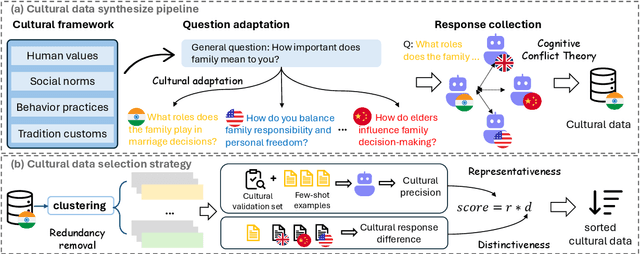

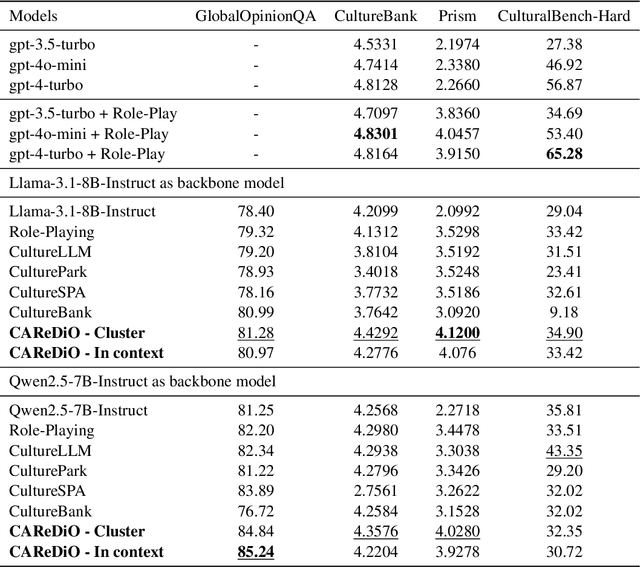
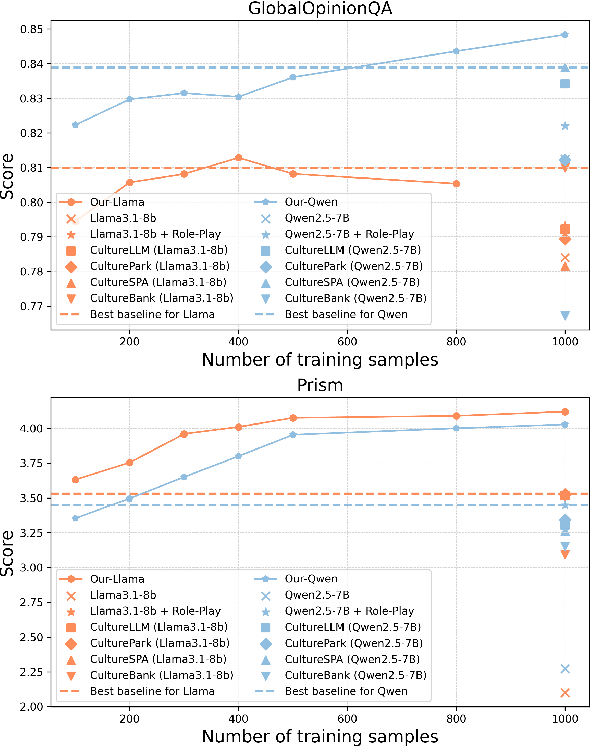
Abstract:As Large Language Models (LLMs) more deeply integrate into human life across various regions, aligning them with pluralistic cultures is crucial for improving user experience and mitigating cultural conflicts. Existing approaches develop culturally aligned LLMs primarily through fine-tuning with massive carefully curated culture-specific corpora. Nevertheless, inspired by culture theories, we identify two key challenges faced by these datasets: (1) Representativeness: These corpora fail to fully capture the target culture's core characteristics with redundancy, causing computation waste; (2) Distinctiveness: They struggle to distinguish the unique nuances of a given culture from shared patterns across other relevant ones, hindering precise cultural modeling. To handle these challenges, we introduce CAReDiO, a novel cultural data construction framework. Specifically, CAReDiO utilizes powerful LLMs to automatically generate cultural conversation data, where both the queries and responses are further optimized by maximizing representativeness and distinctiveness. Using CAReDiO, we construct a small yet effective dataset, covering five cultures, and compare it with several recent cultural corpora. Extensive experiments demonstrate that our method generates more effective data and enables cultural alignment with as few as 100 training samples, enhancing both performance and efficiency.
Research on Superalignment Should Advance Now with Parallel Optimization of Competence and Conformity
Mar 08, 2025Abstract:The recent leap in AI capabilities, driven by big generative models, has sparked the possibility of achieving Artificial General Intelligence (AGI) and further triggered discussions on Artificial Superintelligence (ASI), a system surpassing all humans across all domains. This gives rise to the critical research question of: If we realize ASI, how do we align it with human values, ensuring it benefits rather than harms human society, a.k.a., the Superalignment problem. Despite ASI being regarded by many as solely a hypothetical concept, in this paper, we argue that superalignment is achievable and research on it should advance immediately, through simultaneous and alternating optimization of task competence and value conformity. We posit that superalignment is not merely a safeguard for ASI but also necessary for its realization. To support this position, we first provide a formal definition of superalignment rooted in the gap between capability and capacity and elaborate on our argument. Then we review existing paradigms, explore their interconnections and limitations, and illustrate a potential path to superalignment centered on two fundamental principles. We hope this work sheds light on a practical approach for developing the value-aligned next-generation AI, garnering greater benefits and reducing potential harms for humanity.
SPECIAL: Zero-shot Hyperspectral Image Classification With CLIP
Jan 27, 2025Abstract:Hyperspectral image (HSI) classification aims at categorizing each pixel in an HSI into a specific land cover class, which is crucial for applications like remote sensing, environmental monitoring, and agriculture. Although deep learning-based HSI classification methods have achieved significant advancements, existing methods still rely on manually labeled data for training, which is both time-consuming and labor-intensive.To address this limitation, we introduce a novel zero-shot hyperspectral image classification framework based on CLIP (SPECIAL), aiming to eliminate the need for manual annotations. The SPECIAL framework consists of two main stages: (1) CLIP-based pseudo-label generation, and (2) noisy label learning. In the first stage, HSI is spectrally interpolated to produce RGB bands. These bands are subsequently classified using CLIP, resulting in noisy pseudo-labels that are accompanied by confidence scores.To improve the quality of these labels, we propose a scaling strategy that fuses predictions from multiple spatial scales. In the second stage, spectral information and a label refinement technique are incorporated to mitigate label noise and further enhance classification accuracy. Experimental results on three benchmark datasets demonstrate that our SPECIAL outperforms existing methods in zero-shot HSI classification, showing its potential for more practical applications. The code is available at https://github.com/LiPang/SPECIAL.
Value Compass Leaderboard: A Platform for Fundamental and Validated Evaluation of LLMs Values
Jan 13, 2025Abstract:As Large Language Models (LLMs) achieve remarkable breakthroughs, aligning their values with humans has become imperative for their responsible development and customized applications. However, there still lack evaluations of LLMs values that fulfill three desirable goals. (1) Value Clarification: We expect to clarify the underlying values of LLMs precisely and comprehensively, while current evaluations focus narrowly on safety risks such as bias and toxicity. (2) Evaluation Validity: Existing static, open-source benchmarks are prone to data contamination and quickly become obsolete as LLMs evolve. Additionally, these discriminative evaluations uncover LLMs' knowledge about values, rather than valid assessments of LLMs' behavioral conformity to values. (3) Value Pluralism: The pluralistic nature of human values across individuals and cultures is largely ignored in measuring LLMs value alignment. To address these challenges, we presents the Value Compass Leaderboard, with three correspondingly designed modules. It (i) grounds the evaluation on motivationally distinct \textit{basic values to clarify LLMs' underlying values from a holistic view; (ii) applies a \textit{generative evolving evaluation framework with adaptive test items for evolving LLMs and direct value recognition from behaviors in realistic scenarios; (iii) propose a metric that quantifies LLMs alignment with a specific value as a weighted sum over multiple dimensions, with weights determined by pluralistic values.
The Road to Artificial SuperIntelligence: A Comprehensive Survey of Superalignment
Dec 24, 2024



Abstract:The emergence of large language models (LLMs) has sparked the possibility of about Artificial Superintelligence (ASI), a hypothetical AI system surpassing human intelligence. However, existing alignment paradigms struggle to guide such advanced AI systems. Superalignment, the alignment of AI systems with human values and safety requirements at superhuman levels of capability aims to addresses two primary goals -- scalability in supervision to provide high-quality guidance signals and robust governance to ensure alignment with human values. In this survey, we examine scalable oversight methods and potential solutions for superalignment. Specifically, we explore the concept of ASI, the challenges it poses, and the limitations of current alignment paradigms in addressing the superalignment problem. Then we review scalable oversight methods for superalignment. Finally, we discuss the key challenges and propose pathways for the safe and continual improvement of ASI systems. By comprehensively reviewing the current literature, our goal is provide a systematical introduction of existing methods, analyze their strengths and limitations, and discuss potential future directions.
AeroGen: Enhancing Remote Sensing Object Detection with Diffusion-Driven Data Generation
Nov 26, 2024
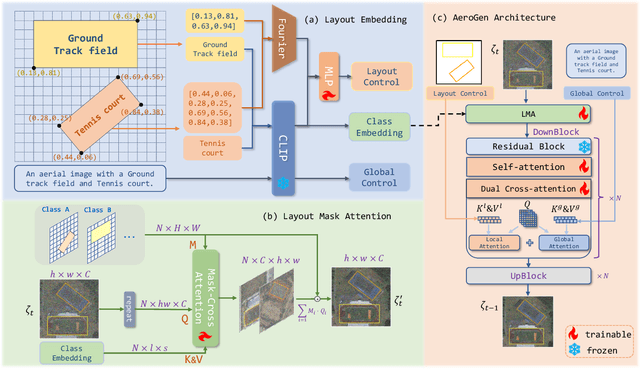

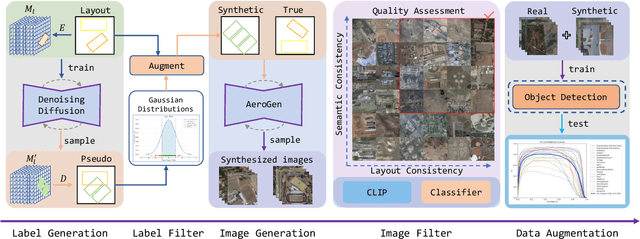
Abstract:Remote sensing image object detection (RSIOD) aims to identify and locate specific objects within satellite or aerial imagery. However, there is a scarcity of labeled data in current RSIOD datasets, which significantly limits the performance of current detection algorithms. Although existing techniques, e.g., data augmentation and semi-supervised learning, can mitigate this scarcity issue to some extent, they are heavily dependent on high-quality labeled data and perform worse in rare object classes. To address this issue, this paper proposes a layout-controllable diffusion generative model (i.e. AeroGen) tailored for RSIOD. To our knowledge, AeroGen is the first model to simultaneously support horizontal and rotated bounding box condition generation, thus enabling the generation of high-quality synthetic images that meet specific layout and object category requirements. Additionally, we propose an end-to-end data augmentation framework that integrates a diversity-conditioned generator and a filtering mechanism to enhance both the diversity and quality of generated data. Experimental results demonstrate that the synthetic data produced by our method are of high quality and diversity. Furthermore, the synthetic RSIOD data can significantly improve the detection performance of existing RSIOD models, i.e., the mAP metrics on DIOR, DIOR-R, and HRSC datasets are improved by 3.7%, 4.3%, and 2.43%, respectively. The code is available at https://github.com/Sonettoo/AeroGen.
Towards Satellite Image Road Graph Extraction: A Global-Scale Dataset and A Novel Method
Nov 23, 2024Abstract:Recently, road graph extraction has garnered increasing attention due to its crucial role in autonomous driving, navigation, etc. However, accurately and efficiently extracting road graphs remains a persistent challenge, primarily due to the severe scarcity of labeled data. To address this limitation, we collect a global-scale satellite road graph extraction dataset, i.e. Global-Scale dataset. Specifically, the Global-Scale dataset is $\sim20 \times$ larger than the largest existing public road extraction dataset and spans over 13,800 $km^2$ globally. Additionally, we develop a novel road graph extraction model, i.e. SAM-Road++, which adopts a node-guided resampling method to alleviate the mismatch issue between training and inference in SAM-Road, a pioneering state-of-the-art road graph extraction model. Furthermore, we propose a simple yet effective ``extended-line'' strategy in SAM-Road++ to mitigate the occlusion issue on the road. Extensive experiments demonstrate the validity of the collected Global-Scale dataset and the proposed SAM-Road++ method, particularly highlighting its superior predictive power in unseen regions. The dataset and code are available at \url{https://github.com/earth-insights/samroadplus}.
 Add to Chrome
Add to Chrome Add to Firefox
Add to Firefox Add to Edge
Add to Edge